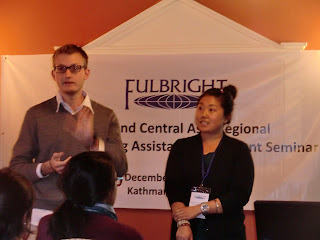**Sorry for the length of
this post…I had a lot to say. Read and be inspired J**
For the winter holiday
break, I had a little over a month off to do just about anything. Unlike the
other Fulbright ETAs who went to exotic places like Goa (the Hawai’i of India),
Thailand or Sri Lanka, I spent my break volunteering. I opted to pursue an
HIV/AIDs health project in Rajasthan (East India) with an organization that
supports women and children who are discriminated against because they have
HIV/AIDs.
 |
| Learn more about Aashray Care Home! |
I was specifically working
with the organizations’ care home for HIV affected and infected children called
the Aashray Care Home (ACH). I lived in that house along with three women, two
of which re HIV+, and thirty children. Of the thirty children, twenty-seven are
HIV+ and twenty are orphans. The mothers of the children who were not orphaned
lived in a separate care home designated for women with HIV.
For the duration of my
time, I was in charge of distributing medicine to the children twice a day,
helping the women cook and clean, I accompanied the children whenever they
needed to go to the hospital, and I facilitated English and health workshops. Majority
of the kids in the home had poor English. Thus, I gave lessons on naming body
parts in English and how to tell someone (i.e volunteers) something hurts. There’s
only one lady managing the care home. She really depends on volunteers to fulfil
errands for the kids. When I was there, I was very important because her son
was going through treatment for his leukaemia and she had to attend to him most
of the time.
Moreover, I applied my
nonprofit management skills when I helped the care home establish their first
newsletter (check it out!) to help them reach out to donors. Also, when the kids went to
school, I got to shadow a female doctor at the local hospital. I basically
helped her give workshops to groups of women currently living in the slums with
their malnourished babies. Following each workshop, we distributed baskets of
vegetables and basic nutrients for the mothers and their babies. Working with
that female doctor was very rewarding. Aside from being with her, I must also
say that being in the government hospital of Rajasthan is an experience in
itself.
In the hospital, every room is packed with people who have been waiting for practically
days to be waited on. It gets even better—in the general room, four or five doctors
sit at a table with people swarming them to look at their sheet (which tells
them why they’re there). You have to be very creative and lucky to get a doctor
to see your paper. After getting your paper reviewed, the doctor then scribbles
several numbers—14, 3, 6, 9, and 7. Each number is a room the patient has to
visit. Each room has its role. When I had to take one of the kids, Ashish,
because he had a HORRIBLE eye infection, a doctor scribbled down three numbers
on his sheet. *I firmly declared I was an American working for an NGO to get
him looked at quickly—CRAZY! Each room we went to was crowded with people.
Considering that I didn’t want to spend too long in the hospital, I passed
through each crowd (using the same excuse) to get Ashish serviced. It is really
sad how I could conveniently use my status as an American to expedite being
serviced at a hospital—UNBELIEVABLE!! While I believe doctors in India are
amongst the best in the world, I wish they could think of a better system to
manage their hospitals.
In the beginning of this experience, I felt very overwhelmed because while in India, I had yet to encounter poverty at this level for such a long period of time. In Kolkata, I am not living luxuriously but comfortable to a certain extent. Not to mention, I am at school Monday through Friday from 7:00AM-1:40PMish. Soon after, I have the choice to go home to my apartment with the other Fulbright ETAs aka other Americans. In this case, I lived day in and day out for about a month with the people I was serving. I was stressed out initially because it bothered me so much to witness firsthand how the women and the kids are ostracised by the rest of their community. Even schools have tried to deny these kids acceptance because they are ‘due to die soon’—UNBELIEVABLE!!
After a while, I saw these
people as more than just people I am here to help, but rather like another
family. In addition to these kids, I grew close with the women and through
translation because I did not know Hindi too well, I learned how they have been
discriminated and outcasted by their own families for being HIV+ (which was
never their fault). This experience overall was detrimental. It instilled in me
a deep passion for numerous facets of global health.
















































